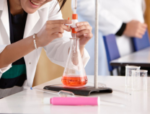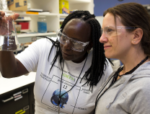Bring green chemistry and sustainable science practices to your classroom by downloading our open-access green chemistry curriculum, attending a teacher training, or asking our experienced Lead Teachers how they began their green chemistry journey.

Green Chemistry Curriculum
K-12 curriculum consists of labs, lessons and units designed by teachers, for teachers that are aligned to state and national standards. Our open-access materials teach green chemistry principles and practices and related STEM topics through the lens of innovation while replacing traditionally hazardous materials with safer alternatives.
View curriculum

Attend a Training
Teacher Trainings provide K-12 science teachers with the skills and tools to teach green chemistry and sustainable science in their classrooms through in-person and online training. To foster an understanding of the economic, human and environmental implications of chemical processes our training content focuses on green technology applications taking place in industry today.
Learn more

Learn from Previous Lead Teachers
Lead Teachers represent K-12 educators with advanced green chemistry training and curriculum expertise who are partnering with Beyond Benign to advance green chemistry and sustainable science among peer educators. This program has concluded, but feel free to learn more from the previous Lead Teachers below.
Learn more
Green Chemistry in Practice
Le Chatelier’s Principle lab
Traditional experiments used to teach equilibrium and Le Chatelier’s Principle involve the use of hazardous compounds like those containing cobalt (II) ions, chromate ions, and thiocyanate ions. Our green chemistry alternative to this lab uses safer materials that can be found at a grocery store. By reducing the hazardous materials used, our lab lowers risks in the classroom and eliminates the need for hazardous disposal.
View a preview of the lab.
Greener Clock Reaction case study
Replacing traditional labs with greener replacements not only reduces the hazards but also purchasing and waste disposal costs. Traditional clock reactions are often taught with a variety of different hazardous reagents. A greener alternative to these labs eliminates the use of many of the traditional chemicals and reduces the total cost of the lab for 500 students from $1,310.35 to $218.25, for an overall cost-savings of $1,092.15.
View the case study.
TAML lab
Green chemistry is a solutions-based science that encourages students to solve a wide array of problems. Labs inspired by cutting edge innovations and Presidential Green Chemistry Challenge Award winning technologies capture the imagination of students while incorporating key science standards.
View the lab.
